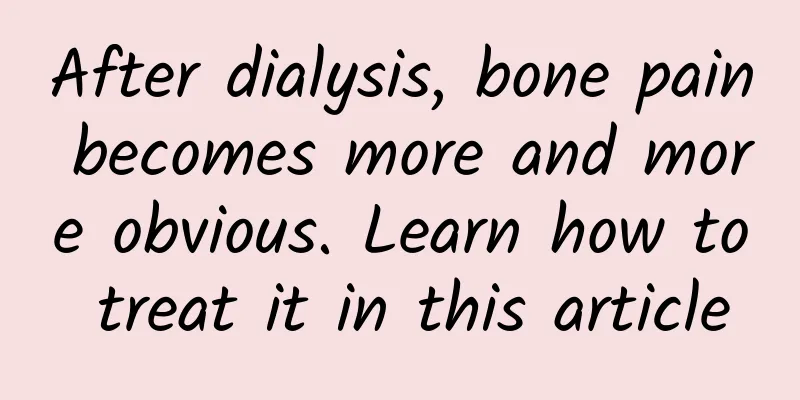After dialysis, bone pain becomes more and more obvious. Learn how to treat it in this article

|
1. Adjusting the dialysis regimen Communicate with your doctor to assess whether the current dialysis is adequate. You may need to increase the frequency of dialysis, extend the dialysis time, or adjust the dialysate composition. For example, adjust the calcium and phosphorus concentrations. The appropriate dialysate calcium ion concentration helps maintain calcium balance in the body and reduce bone pain caused by calcium metabolism disorders. 2. Control calcium and phosphorus levels 1. Limit the intake of phosphorus in the diet and avoid eating high-phosphorus foods, such as animal offal, nuts, etc. At the same time, use phosphorus binders reasonably according to the doctor's advice and take them at the same time as meals to effectively reduce the intestinal absorption of phosphorus. 2. For abnormal blood calcium, adjust the use of calcium supplements under the guidance of a doctor. If blood calcium is too high, reduce the use of calcium-phosphorus binders; if blood calcium is too low, supplement calcium appropriately, but be careful to avoid vascular calcification. 3. Application of Active Vitamin D Detect the level of vitamin D in the body and use active vitamin D and its analogs according to the situation. It can promote intestinal absorption of calcium, regulate the secretion of parathyroid hormone, and help improve bone metabolism. However, it is necessary to pay attention to monitoring blood calcium, blood phosphorus and parathyroid hormone to prevent adverse reactions. 4. Treatment of hyperparathyroidism If the bone pain is caused by hyperparathyroidism, drug treatment can be selected according to the condition, such as calcimimetics, which inhibit the secretion of parathyroid hormone. For severe parathyroid hyperplasia or adenoma, surgical treatment may need to be considered. V. Rehabilitation and auxiliary treatment Appropriate gentle exercise, such as joint range of motion training and low-intensity aerobic exercise, can help improve bone blood circulation and muscle strength and relieve bone pain. At the same time, auxiliary methods such as hot compresses and massage can be used to relieve local pain symptoms. However, when performing these operations, care should be taken to avoid damaging fragile bones. |
<<: Those who have kidney disease and can live to 80 years old basically do these things
>>: Not all dairy products are suitable for kidney patients, especially these ones!
Recommend
The golden period for weight loss after menstruation
Women will choose different methods when losing w...
Precautions for vertical incision pregnancy
If you want to have a second child through vertic...
What happens if you drink alcohol while pregnant?
Usually there is no connection between pregnancy ...
Is it ok to have sex once during menstruation?
You must not have sex during menstruation. Becaus...
Female genitalia
The reproductive organs are the part of the sex o...
Treatment for postpartum back pain
The most important thing in a woman's life is...
Why do we have more “black spots” on our bodies as we age? Does it have any impact on our health?
A friend told Huazi that as he grew older, he fou...
Four-dimensional color Doppler ultrasound can rule out Down syndrome, three factors to understand early
During pregnancy checkups, four-dimensional color...
RBC Capital Markets: Purchase intention survey shows that iPhone still leads all competitors
Consumers are very aware of and interested in the...
Episiotomy recovery chart
Women will encounter some problems during natural...
Should I refrigerate or freeze the leftover salmon? How can I avoid parasites when eating salmon?
Salmon (scientific name Oncorhynchus) means "...
My stomach feels hard and tight after my due date
In our lives, we all know that the most obvious c...
What are the dangers of having sex on the first day of menstruation?
Many women have sex during their menstrual period...
What causes swelling during menstruation?
Women will experience many discomforts during men...
Is it better to do non-invasive or Down syndrome test at 12 weeks of pregnancy? What tests should be done at 12 weeks of pregnancy?
We all know that after a woman becomes pregnant, ...









